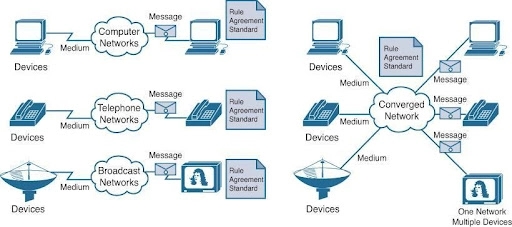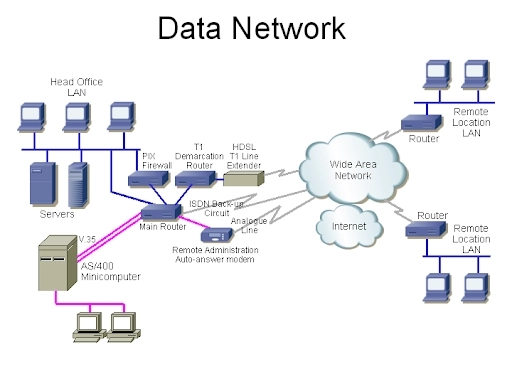Demystifying the Data Network: Understanding the Basics of Modern Networking Infrastructure

Demystifying the Data Network: Understanding the Basics of Modern Networking Infrastructure
A modern network infrastructure is the collaborative integration of the fundamental components associated with running an enterprise IT network. It is an integral part of the overall IT infrastructure and helps to run operations seamlessly.

As enterprises rely heavily on IT networks to run mission-centric applications or other operations, it becomes important to ensure that the network is secure, robust, scalable and reliable.
Data networks are specifically designed to transfer data between various access points through the use of data exchanges, transmission lines, and system controls. IT network infrastructure is made up of many verticals, but the importance of data networking is somewhat underestimated.
A data network is unique from other components in the infrastructure in that it can only be used to transport data. This article provides a detailed look at data networking and its application in a business environment.
Fundamentals of modern network infrastructure

Modern network infrastructure is a combination of software applications, network services and hardware devices. The hardware infrastructure consists primarily of switches, repeaters, modems, bridges, and other such devices, while the software infrastructure consists of management and monitoring tools and operating systems.
Network services within the infrastructure consist of specific protocols such as IP addressing, UDP and TCP. These organizations extend their IT networks by partnering with managed service providers or launching hybrid infrastructures to build networking solutions.
The fundamental purpose of network infrastructure design is to help plan how to implement, manage and monitor enterprise IT networks. A network infrastructure design should only be proposed after a proper assessment of operational necessity, taking into account bandwidth, resiliency, security, quality of service, and capacity.
After performing the design, it will be possible to understand the specific roles of all network components. Learn how any piece of equipment responds to a failure, or how it will impact operational practices. The ultimate goal is to ensure that business-critical data continues to flow within the network without any interruption.
The Importance of a Modern Network Infrastructure
When a business thrives and implements a good workflow, the amount of data transferred within the corporate network will increase dramatically. If your data network infrastructure is not optimized with modern parameters, the system will come under stress and cause downtime.
Therefore, ensuring the reliability of the network is of paramount importance to avoid more severe downtime scenarios or loss of business-critical data. Assume that any form of disaster affects the organization's ability to operate. In such cases, having a properly equipped and reliable network will ensure an easy and quick recovery of the system.
Enterprises should invest in optimizing their entire network infrastructure to prevent losses due to avoidable oversights.
What is a data network?

A data network within an infrastructure is defined by its potential to transmit signals through the concept of packet switching. In this setup, data messages are broken down into small bits, known as packets, and sent over a digital network. That digital network then uses a specific route with the best data network speed and little or no lag.
Once the data is transmitted, these small packets or bits of data are reassembled at the destination to convey the information. The flow of data within a data network supports the transmission of digital messages among devices such as cell phones, radios, computers, etc.
Data flowing and communicating within a network can be classified into simplex communication and duplex communication. Simple communication allows data to flow in only one direction, from the sender to the receiver. Duplex communication, on the other hand, enables data to flow back and forth between the sender and receiver.
In addition, data networks are divided into public and private, with significant differences between the two, including:
private data network
The purpose of a private data network is to facilitate the transfer of data between employees and multiple organizational departments. For all businesses with offices in different locations, dedicated data network infrastructure can be implemented to facilitate data transfer and communication through secure centralized servers.
public data network
Public data networks are entirely limited to users and systems within a single enterprise. Business entities and individuals can access wherever they are. Implementing multiple servers, cell towers, and communication protocols to create a public network facilitates the transfer of data regardless of distance. Users will need some form of credentials to use this data network.
Different types of data networks in modern infrastructure
Modern network infrastructure is driving the use of various types of data networks categorized by coverage, physical architecture, and size. Some of them are as follows:
Personal Area Network (PAN)
A PAN data network is used to connect computers and other devices within a user's personal workspace.
local area network (LAN)
A LAN data network utilizes routers, switches, access points, and cables to support the interconnection of all organizational equipment with internal servers that are confined to a confined space such as an office or building.
Metropolitan Area Network (MAN)
The working principle of the metropolitan area network data network is exactly the same as that of the local area network, but the coverage area is expanded accordingly. With a MAN, devices or organizational endpoints can connect to internal servers, spanning a campus or various buildings within a specific area.
Wide Area Network (WAN)
Ideally, WANs are used to extend information sharing and communication capabilities to diameters of 50 kilometers or more. It's best explained as a collection of multiple LAN data networks.
Benefits of Harnessing the Potential of Data Networks in a Modern Infrastructure
There are many benefits to implementing data networking in a modern business network infrastructure. Here are some of them:
enhance communication
The biggest benefit of using data networks effectively is that it facilitates faster, more seamless communications. All connected systems within a data network can interact with each other and transfer files without any physical medium.
better collaboration
Through the integration of data networks, seamless collaboration can be established between two geographically distant teams. Multiple users connected via a data network can work on the same document or project remotely.
optimal resource sharing
Once a data network is implemented, there is no need for more physical connections within an organization's infrastructure to share information. This means that all resources, such as storage media, printers, and the Internet, are located between the two nodes.
Summarize
There has been continuous innovation and advancement in data networking, and the way data is now shared or transmitted has evolved. As of now, network-related operations are critical to predicting network behavior to identify the potential for system failures, security breaches, and other bottlenecks
By using the right network monitoring and integration solutions, you will be able to ensure consistent data bits or packet flow across all data networks.
Frequently Asked Questions
Q: What are the basic functions of network infrastructure?
Network infrastructure consists of software and hardware devices and systems that support communication and computing functions among applications, processes, and users. Everything on the network, from wireless routers to servers, together builds the network infrastructure of the system.
Q: Why is it important to build a system network infrastructure?
Establishing the network infrastructure builds the overall backbone of communications throughout the enterprise. The basis of the entire network activity is based on the efficacy of the network infrastructure. Therefore, data exchange, video service and voice service between various devices will become possible.
Q: What are the seven different domains related to network infrastructure?
The seven key areas of IT infrastructure are:
- workstation domain
- LAN-WAN domain
- workstation domain
- application/system domain
- LAN domain
- WAN domain
- remote access domain